Ground-Based Observations of Nuclear Surface of Comet 2P/Encke
|
Home page |
Updated on July 21, 2005 |
![]()
|
Comet 2P/Encke is a short periodic comet which passes only 0.33 A.U. from the sun every 3.3 years. It is nearly extinct, about to be an asteroid in the near future. Comet 2P/Encke looks like an asteroid when far from the sun. It does not brighten even getting closer to the sun. Just before the perihelion passage, it suddenly start brightening rapidly, and becomes visible visually in a short time. It looks extremely diffused visually. These are typical features of an old gas-rich periodic comet. In 2003 November, Comet 2P/Encke approached to the earth down to 0.26 A.U. It looked very large and extremely diffused visually, however, it looked almost stellar on the CCD images at the same time. 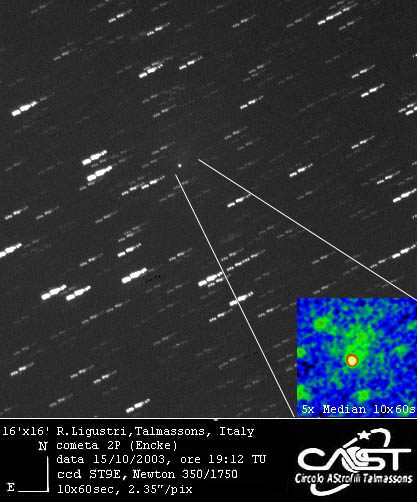 CCD Image by Rolando Ligustri on October 15. 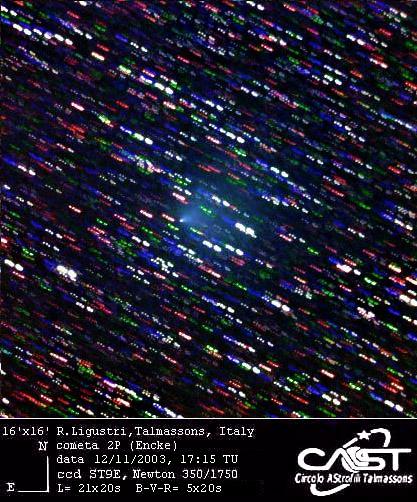 CCD Image by Rolando Ligustri on November 12. In general, a nucleus of a comet is hidden by the surrounding gas and dusts and not observable directly on the earth. However, the nucleus itself of Comet 2P/Encke was probably observed even using a small telescope by amateurs. The following light curve shows the nuclear magnitude published in the M.P.E.C.s. Apparent effect due to the geocentric distance is deducted in this graph. 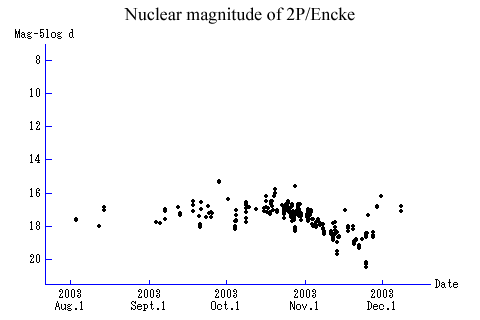 Nuclear magnitude published in the M.P.E.C.s. Comet 2P/Encke was observed from August to early December in 2003. The heliocentric distance reduced from 2.3 A.U. to 0.63 A.U. in this period. However, the nuclear magnitude had been almost constant, did not brighten at all. Especially, unusual decline of the nuclear magnitude was observed after late October. The following light curve shows the total magnitude observed visually. Comet 2P/Encke brightened rapidly in this period. Therefore, the unusual decline of the nuclear magnitude does not mean the decline of the comet's activity. 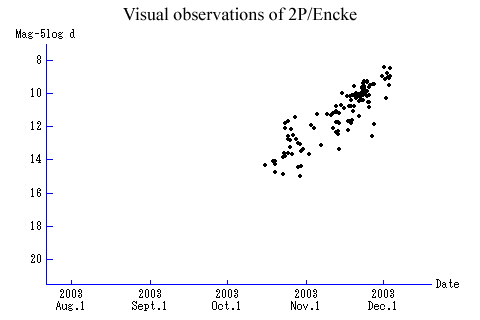 Visual observations. Because the nuclear magnitude published in the M.P.E.C. are not results of accurate photometry, the decline can be an artificial effect based on the measurement methods, instrumental problems, etc. I verified the result only using the accurate nuclear magnitude measured by Akimasa Nakamura. All of Nakamura's observations satisfy the following conditions.
Here is the result of Nakamura's unfiltered CCD photometry on seven nights. The nuclear magnitude are measured using three aperture sizes for comparison, 5x5 pixels (7.1x7.1 arcsec), 7x7 pixels (10.0x10.0 arcsec), and 9x9 pixels (12.8x12.8 arcsec).
Date(UT) 5x5 7x7 9x9
-----------------------------
Sept. 3.65 18.7 18.5 18.5
26.72 17.6 17.2 17.1
Oct. 17.57 15.7 15.6 15.5
19.56 15.9 15.7 15.6
23.65 15.9 15.6 15.4
29.65 15.7 15.5 15.3
Nov. 16.49 16.0 15.6 15.3
The following light curves shows the Nakamura's photometry. 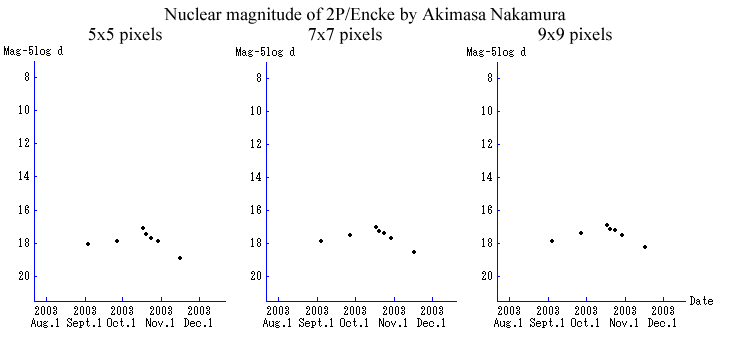 Nuclear magnitude by Akimasa Nakamura. The unusual decline of the nuclear magnitude was evident. Therefore, the nucleus of Comet 2P/Encke really faded in this period. The following light curve shows the observed nuclear magnitude of Comet 2P/Encke, and the curves of theoretical nuclear magnitude. 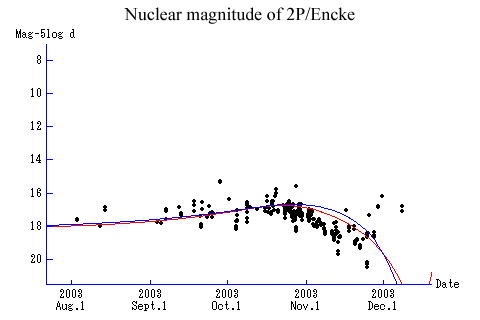 Theoretical curves and observations. The formula of the theoretical nuclear magnitude is: m2 = H + 5 log(delta) + 5 log(r) - 2.5 log( (1-G) * phi1 + G * phi2 ) phi1 = e^( -3.33 * tan(beta/2)^0.63 ) phi2 = e^( -1.87 * tan(beta/2)^1.22 ) m2 : Nuclear magnitude. H : Standard nuclear magnitude at 1.0 A.U. from the sun and the earth. G : Reflection parameter. delta : Geocentric distance. r : Heliocentric distance. beta : Phase angle. The blue curve in the graph means H = 15.3, G = 0.50. The red curve means H = 14.8, G = 0.05. The decline of the nuclear magnitude is calculated theoretically because the phase angle became large in this period. If the apparent stellar nucleus observed on the earth is gas and dusts around the nucleus, and if the nuclear surface of Comet 2P/Encke is not observable directly on the earth, the decline of the nuclear magnitude cannot be explained. Therefore, the decline implies that the nuclear surface of Comet 2P/Encke was observed indeed. The reflection parameter of a typical asteroid is G = 0.15. The red curve with G = 0.05 coincides better than G = 0.50 with the observations, which suggests the surface of the nucleus is dirty. It does not conflict with the observations of comet's nucleus by spacecrafts. The theoretical curve suggests the nuclear magnitude becomes extremely faint after mid November. Actually, Masayuki Suzuki reported the nucleus of Comet 2P/Encke became hard to see on his CCD images after mid November as follows. 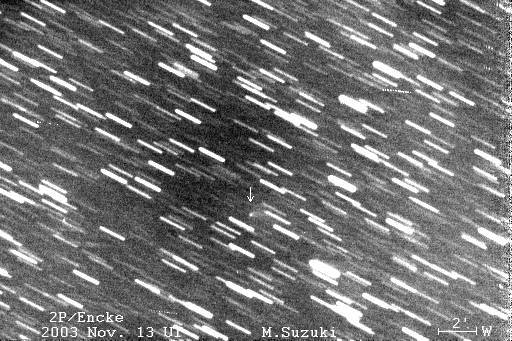 Masayuki Suzuki's CCD image on November 13. 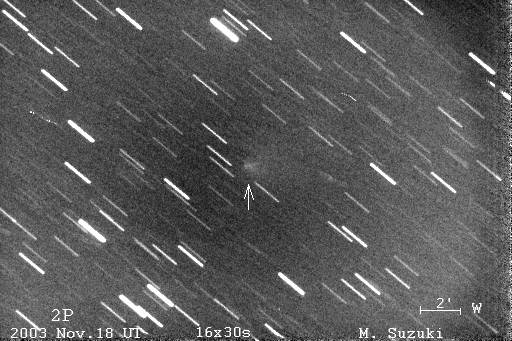 Masayuki Suzuki's CCD image on November 18. 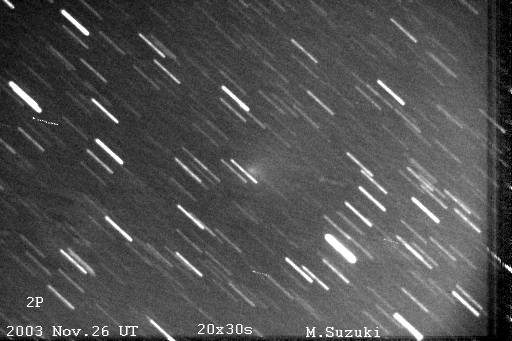 Masayuki Suzuki's CCD image on November 26. |
![]()